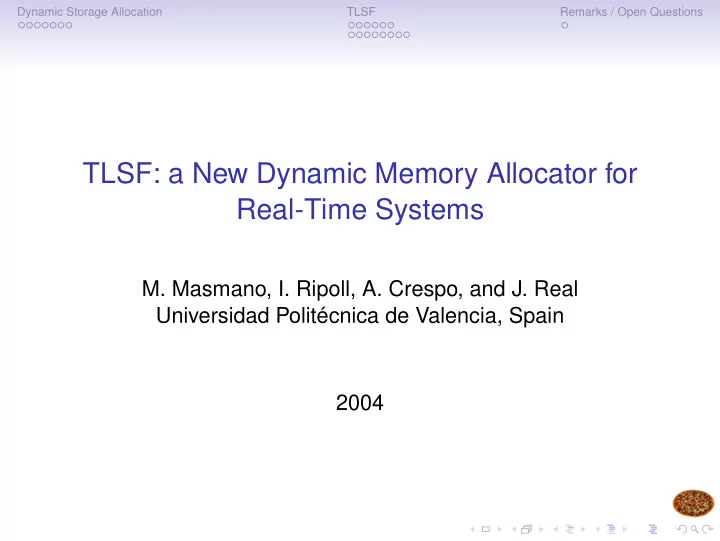

Dynamic Storage Allocation TLSF Remarks / Open Questions TLSF: a New Dynamic Memory Allocator for Real-Time Systems M. Masmano, I. Ripoll, A. Crespo, and J. Real Universidad Politécnica de Valencia, Spain 2004
Dynamic Storage Allocation TLSF Remarks / Open Questions Motivation • Dynamic storage allocation (DSA): well studied and analysed issue for most application types • Most DSA algorithms: good average response times, good overall performance • In real-time scenarios rarely used: worst-case response time too high
Dynamic Storage Allocation TLSF Remarks / Open Questions "Developers of real-time systems avoid the use of dynamic memory management because they fear that the worst-case execution time of dynamic memory allocation routines is not bounded or is bounded with a too important bound" (I. Puaut, 2002)
Dynamic Storage Allocation TLSF Remarks / Open Questions Real-Time Requirements for DSA timing constraints Real-time systems: schedulability analysis ⊲ determine the worst-case execution time ⊲ application schedulable with it’s timing constraints? Therefore: • Bounded response time • Fast response time • Memory requests need to be always satisfied
Dynamic Storage Allocation TLSF Remarks / Open Questions Fragmentation memory constraints Real-time systems: run for large periods of time → memory fragmentation problem Memory exhaustion • Application requires more memory than available • DSA algorithm is unable to reuse memory that is free • Internal fragmentation (metadata and alignment, e.g. 10 byte memory + 8 byte header + 4/8 byte alignment) • External fragmentation (many small pieces)
Dynamic Storage Allocation TLSF Remarks / Open Questions DSA Algorithms • Sequential Fit : single or double linked list (First-Fit, Next-Fit, Best-Fit) • Segregated Free Lists : array of lists with blocks of free memory of the same size (Douglas Lea DSA) • Buddy Systems : efficient split and merge operations (Binary Buddies, Fibonacci Buddies) → good timing behaviour, large fragmentation • Indexed Fit : balanced tree or Cartesian tree to index the free memory blocks (Stephenson’s "Fast-Fit" allocator) • Bitmap Fit : a bitmap marks which blocks are busy or free (Half-Fit algorithm) data structures are small (32 bit) → less cache misses
Dynamic Storage Allocation TLSF Remarks / Open Questions DSA Operational Model DSA algorithm • keeps track of which blocks are in use and which are free • must provide at least two operations (malloc / free) Typical management of free memory blocks • Initially a single, large block of free memory • First allocation requests: take blocks from the initial pool • A previously allocated block is released: merge with other free block if possible • New allocation requests: from free blocks or from the pool
Dynamic Storage Allocation TLSF Remarks / Open Questions DSA Operational Model Basic operations to manage free blocks • Insert a free block (malloc/free) • Search for a free block of a given size or larger (malloc) • Search for a block adjacent to another (free) • Remove a free block (malloc/free) • Split and merge
Dynamic Storage Allocation TLSF Remarks / Open Questions Two-Level Segregated Fit - Design • Targets embedded real-time systems (trusted environment, small amount of physical memory available, no MMU) • Immediate coalescing • Splitting threshold (16 byte) • Good-fit strategy • No reallocation • Same strategy for all block sizes • Memory is not cleaned-up
Dynamic Storage Allocation TLSF Remarks / Open Questions Two-Level Segregated Fit - Example 1 memory used to manage blocks • maximum pool of 4 GB (FLI=32, SLI=5) → 3624 bytes • maximum pool of 32 MB (FLI=25, SLI=5) → 2856 bytes
Dynamic Storage Allocation TLSF Remarks / Open Questions First Level Index (FLI) / Second Level Index (SLI) • Array of lists, each holding free blocks within a size class • Each array of lists has an associated bitmap • First-level: divides free blocks in classes (16, 32, 64, ... ) • Second-level: sub-divides each first-level class linearly SLI = 4 ⇒ bits 4-7 SLI = 4 ⇒ 16 sub classes class 8 : 256 ... 512 12 th sub class : 256 + 12 ∗ ( 256 / 16 ) = 448 ... 464
Dynamic Storage Allocation TLSF Remarks / Open Questions Two-Level Segregated Fit - Example 2
Dynamic Storage Allocation TLSF Remarks / Open Questions TLSF Data Structures typedef struct TLSF_struct { // the TLSF’s structure signature u32_t tlsf_signature; // the first-level bitmap // This array should have a size of REAL_FLI bits u32_t fl_bitmap; // the second-level bitmap u32_t sl_bitmap[REAL_FLI]; bhdr_t *matrix[REAL_FLI][MAX_SLI]; } tlsf_t;
Dynamic Storage Allocation TLSF Remarks / Open Questions TLSF Block Header
Dynamic Storage Allocation TLSF Remarks / Open Questions Statistics • AMD Duron 807 MHz • rdtsc before/after alloc()/free() • libc vs. buddy slab vs. tlsf
Dynamic Storage Allocation TLSF Remarks / Open Questions Statistics : malloc 1-1024 bytes
Dynamic Storage Allocation TLSF Remarks / Open Questions Statistics : malloc 1-1024 bytes
Dynamic Storage Allocation TLSF Remarks / Open Questions Statistics : malloc 1-1024 bytes
Dynamic Storage Allocation TLSF Remarks / Open Questions Statistics : free 1-1024 bytes
Dynamic Storage Allocation TLSF Remarks / Open Questions Statistics : malloc 1-1024 distribution
Dynamic Storage Allocation TLSF Remarks / Open Questions Statistics : malloc 1-1024 distribution
Dynamic Storage Allocation TLSF Remarks / Open Questions Statistics : free 1-1024 distribution
Dynamic Storage Allocation TLSF Remarks / Open Questions Remarks / Open Questions • Synthetic workload? ("Dynamic Storage Allocation: A Survey and Critical Review") • Do real-time applications really need such a general purpose DSA? • Usable for non-real-time applications? (higher response time vs. low upper bound)
Recommend
More recommend